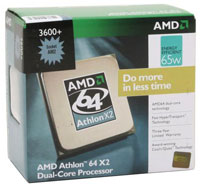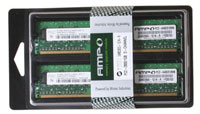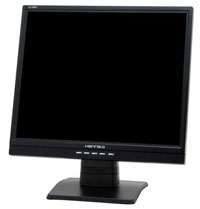Entry Level AMD
The great thing about purchasing a computer right now is that you can get a serious amount of performance for a reasonable price. Our entry level configuration will look to keep price as low as possible without making any major compromises. However, without spending a bit more money it is impossible to purchase a basic computer that will do everything well. The biggest compromise we are making is in the graphics department, where the use of integrated graphics basically means that gaming performance is going to be crippled. For the many people out there that don't care about games, that shouldn't present a problem. It is also relatively simple to upgrade a computer with a discrete graphics card in the future should the need/desire arise.
| AMD Entry Level System |
| Hardware |
Component |
Price |
Rebates |
| Processor |
Athlon 64 X2 3600+ AM2 (Brisbane 1.9GHz 2x512K) - Retail |
$72 |
|
| Motherboard |
ASUS M2A-VM (Socket AM2 AMD 690G) |
$77 |
|
| Memory |
WINTEC AMPO 2x512MB DDR2-800 (5-5-5-12 3AMD2800-1G1K-R) |
$65 |
|
| Hard Drive |
Western Digital Caviar SE16 WD2500KS 250GB 16MB |
$70 |
|
| Optical Drive |
Lite-On 20X DVD+R LH-20A1P-185 |
$34 |
|
| Case |
RAIDMAX APEX ATX-802BP with 450W PSU |
$65 |
|
| Display |
Hanns-G JC-199DPB 19" 8ms (1280x1024) |
$184 |
$40 |
| Speakers |
Cyber Acoustics CA3001WB 14 watts 2.1 Speakers |
$24 |
|
| Keyboard and Mouse |
Microsoft Comfort Curve 2000 B2L-00047 |
$28 |
|
| Operating System |
Windows MCE 2005 or Vista Home Premium (OEM) |
$115 |
|
| Bottom Line |
|
$734 |
$694 |
 |
Prices on AMD's dual core processors are now so low that we see little reason to avoid them. You could shave another $20 off the price by going with a single core Athlon 64 3000+, but that extra $20 buys you potentially twice as much performance. Dual core and multi-core processors are the future, and for those planning to purchase an inexpensive computer and use it for years to come we would just spend the extra money now. The Athlon X2 3600+ (Brisbane core) runs at 1.9GHz and comes with 512K cache per core. Do not confuse this with the 2.0GHz 256K version (Windsor core); the extra cache will almost certainly prove more useful than the extra 100 MHz. For those looking to really cut costs, if you don't want a dual core processor you might as well drop all the way down to the Sempron 64 3000+ (1.6GHz 256K cache) that costs a mere $33. Just don't expect that processor to handle the demands of many applications in three years' time.
 |
Perhaps the most difficult component to get right in any custom-built system is the motherboard. This is particularly true when looking at the budget sector. Buying the least expensive option is rarely the best course of action as features, reliability, stability, and performance can all be compromised. Luckily, the situation is generally better now than it has been in the past, and the integrated memory controller on AMD's processors usually means features and reliability are the only major concerns. For the current cost, the features and performance offered by AMD's 690G chipset put it at the top of our list. Besides a reasonably performing IGP solution - arguably the fastest currently available, though that isn't saying much - you can get VGA, DVI, as well as HDMI video outputs. The ASUS M2A-VM is a micro ATX solution with most of these features, available at a bargain price of only $77. Adding HDMI support will increase the price about $20. It certainly isn't one of the "everything but the kitchen sink" designs, though you can't usually find that without moving beyond the budget sector. This motherboard should also allow at least a moderate amount of overclocking if that's of interest, but that isn't a primary concern here.
 |
We chose DDR2-800 memory, simply because the cost is now at parity with other slower DDR2 memory (i.e. DDR2-667). Memory prices have also become much more reasonable since the beginning of the year, and we're back at the point where 2GB of RAM is available starting at just over $100. We decided not to go that far on entry level configuration, but if you're thinking about running Windows Vista as opposed to Windows XP we would strongly recommend upgrading the memory. On the bright side, at least even micro ATX motherboards are generally offering four DIMM slots these days. For the majority of users, memory timings and overclocking definitely aren't concerns in the budget sector, so we selected an inexpensive Wintec AMPO kit.
For the remaining items, we tried to keep the price down while keeping features and performance as high as possible. We could certainly trim things a bit further (for example getting a 160GB or even 80GB hard drive can save $15-$20), but we prefer to spend slightly more if possible. Getting a less expensive case is something else to consider, and of course those who prefer a little bling have plenty of budget options available. Provided you just want to stay with the basics, you can basically get any cheap case plus power supply and not have any difficulties, but we would still pay attention to user reviews and experiences and do a bit of research first.
 |
The only other major component remaining is the display, and here we were presented with several options. 17" LCDs are the least expensive choice right now, but once you factor in mail-in rebates it really only costs a few dollars more to get a 19" LCD. Some people might actually like the slightly smaller LCD for whatever reason, but we would definitely take a larger LCD first. Looking at the 19" LCDs, you then have to decide between standard aspect ratio and widescreen offerings. We like widescreens for the most part, but it seems like corners are being cut on the panels in order to keep costs down, and actual surface area is slightly larger on a standard aspect ratio display. Hanns G is one of many display manufacturers that most people aren't familiar with, but the reality is that there are only a few actual panel manufacturers. The quality of LCD panels has also reached the point where even the budget offerings look good and perform well. Long-term quality and support is a bit harder to judge, but the average user consensus is that this particular LCD is a very good budget option.














46 Comments
View All Comments
JarredWalton - Saturday, April 21, 2007 - link
I'd take the features of the 690G over the older nForce 61x0 boards... but then I like that HDMI connection. If you're willing to spend a bit more money, getting the Biostar is the way I'd go. Or spend even more money and just get an entry level GPU, but that would add at least $100 if you want something that can run most games at moderate detail settings. NVIDIA is supposed to be working on an updated IGP, so I'm interested to see what they come out with. If they actually put 8 pixel pipes in an IGP, I'd be ecstatic.As for abit, your abit fetish is well known. ;) I wouldn't get the entry level ASUS for overclocking, but I've got their 939 equivalent (6100 chipset) and it's been running fine for a year or so... even with a 20% overclock on a 3800+. Sometimes I need to boot twice because the first POST will fail, but if it boots it's rock solid. Anyway, ASRock is quirky in my opinion, but if you're willing to go with basic parts and not overclock they're usually fine as well. Just stay away from the VIA chipsets.
yyrkoon - Sunday, April 22, 2007 - link
Forgot to mention: has proven to work for me for over 10 years.JarredWalton - Sunday, April 22, 2007 - link
I really liked abit back in the socket 370 era (and the slot 1 timeframe as well). Their Pentium 4 boards didn't do as much for me, and only recently have they started to recover in my opinion. I haven't tried the latest boards, but Gary's experiences with the initial release BIOS on several has been less than stellar. Like most companies, they have hit and miss products these days.My old Abit IT5H with a Pentium MMX 200 at 250 MHz was a great system back in the day. I had that system running for at least 5 years - first for me and then for my brother. BE6 and BE6-II were also decent boards, but I had both models fail from leaky capacitors. Abit was good enough to replace the boards (even though one was three years old), but I think the caps issue seriously hurt them for a while. They must have lost a ton of money replacing boards.
yyrkoon - Monday, April 23, 2007 - link
Oh, by the way, we recently sold a system, used, to a customer, that had a BE6 board in it, still works great. We also have ~10 other ABIT boards, all lying about, out of service, but still functional. Then again, we also have some Tyan, and Intel boards(dual slot workstation/server boards), that are fairly old lying about also . . .yyrkoon - Monday, April 23, 2007 - link
RIGHT_NOW, we have 5 systems, all using ABIT boards, all working great. These include an AS8, an AW8-MAX. 2x NF-M2 nViews,and an NF7-S2G. Two of these I own personally.The NF7-S2G had to be replaced, it died a premature death, from what I can tell, it was becasue I was using a very old compaq keyboard ( I still love this keyboard ), that kept comming out of the PS2 port, and eventually, the board died because of it. The AS8 is owned by my business partner, he bought it becasue the ASUS board he bought was dead out of the box (that made 4 in a row for us, over the course of a year, so we stopped using them period). Anyhow, the AS8 exibited dailey lockups, and crashed, we couldnt figure out what was happening for some time. Turned out, it was not the board that was at fault, but the ATI 9600 Pro card, drawing too much power off of the AGP port (found the fix on ABITs forums, the system has been flawless since). The other systems run next to perfect, if not perfect, all are very stable.
I have owned boards made from just about any manufactuer you can think of, and have had some by companies that are no longer in business, and the reason why I keep going back to ABIT, is because I get tired of the hassles other board OEMs make you go through. However, it is not like ABIT boards are perfect, but I have yet to run into an ABIT board, that was really not at fault, or if it was at fault, the issue was easily correctable. Jarred probably knows about my most recent exploit outside of the ABIT realm, which invloved an ASROCK board, which to say, this ABIT NF-M2 nView replaced . . . and I am very happy I did replace it.
I have also owned one of the 'leaky capacitor' ABIT boards, and since my business partner here has been an EE for nearly 30 years, he replaced the caps for me, no problem, although, the board has become otherwise unstable, and I am not sure why(does not really mattter, it was a socket A board, that I hacked the BIOS on to run the next generation of socket A 2000+ XP processor on anyhow, but the board ran fine for 5 years). That being said, this was not JUST ABIT this happened to alone, it happened to many OEMs that used japanese caps around this time, and I bet the company responcable, is no longer in business.
I have good will towards many motherboard OEMs, MSI, Gigabyte, Tyan just to name a few, and if ABIT were to go out of business right now, I am not sure which brand I would be using next, but it would probably be one of those, but I have YET to run into the random problems people claim they have with the random ABIT board, and I usually chalk it up to inexperienced users, trying to build a system. Although, I suppose there could be faulty boards, in a good line . . . My biggest latest problem with ABIT: my NF-M2 nView WILL_NOT boot with a USB HDD powered on , and attached. Well sometimes it will, but it will never make it into windows, until I power down the USB device. Not sure what the problem is, and I suppose it could be fixable to changing a BIOS setting (maybe setting USB devices compatable with thge USB 1.1 standard i nthe BIOS?), but this issue is really, really a minuscule issue in my opinion.
Maybe my luck with ABIT has just been good ? If that is the case, something is going on, becasue like I have said before, I have been using almost exclusively ABIT boards (yes, there are a few exceptions) for the last 10-11 years. If I am a 'fanboy', that would be the reason why.
Zirconium - Sunday, April 22, 2007 - link
I still remember the BP6 days when Abit was the only one with 1 MHz clock speed adjustments. I still remember how (nerd) pimp I thought I was, running dual 300 MHz celerons OC'd to 450 MHz.yyrkoon - Sunday, April 22, 2007 - link
Yeah, I not unlike other people stick with things that have proven to work for me. It is pretty much that simple.
Sunrise089 - Friday, April 20, 2007 - link
Thanks for updating the guide Jarred. I think you got the price points just right this time, even if you named them wrong. It really isn't an AMD Gaming vs an Intel Overclocking, it's just the smartest decisions for each at a $1500 price point. Too often in the past the guide hasn't stuck to a set price, instead just calling it "midrange", and therefore AMD's $1300 midrange configuration would get outclassed by Intel's $1600 configuration. Keeping the prices closer helps us see that while we'd all rather have Core 2 Duo in our machines, it does necessatate trade-offs to keep the price competitive.Now if you can, how 'bout making these come out a bit more often?
tacoburrito - Friday, April 20, 2007 - link
Considering that the Penryn and Barcelona are coming out later this year, which will mean lower prices for the current generation of procs, is now really a good time to buy and build based on current procs?KeypoX - Saturday, April 21, 2007 - link
i agree it isnt a good time ... we are in the middle of another transition and we should wait till it levels out. I think the marketing job intel is doing with these price cuts is awesome though. They are about to make a boat load of money.